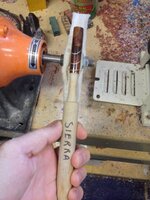I made it through my first pen last week. It turned out better than expected (the pieces actually fit together and it looked ok—woohoo!) but there's a lot of room for improvement. I have a few process questions that I wanted to ask here.
My biggest challenge in the entire process was the barrel trimming. I used my lathe to drill the blanks and to do the barrel trimming and either I'm doing something wrong or my barrel trimmer bits are pieces of junk. They do a good job for the first 1/16th of an inch or so but then they stop cutting. No matter how much I tightened the tailstock, nothing happened.. It was like the barrel trimmer bit or maybe the drill chuck would just compact the more I tightened the tailstock. For my next pens I was planning on cutting the blanks a little closer to the final tube size so I won't have to trim as much but I wanted to ask you guys if it's worth it to buy another new barrel trimmer?
Second question… general guidance request.. What cutting tools do you guys mainly use when turning pens? I've been having the most success with my spindle gouge. I lucked out in getting a really sharp edge on it and that thing was really working for me. It helped me get a nice even diameter on the pen blank I was turning. My set also includes a couple of skew chisels so I tried sharpening and using those.. and um.. Let's just say I'm pretty terrible with them. All I accomplished with those was making unwanted and uneven cuts in the blank. Do you guys use skews when turn your pen blanks? Maybe I'm doing something wrong, not getting them sharp enough, etc?
Thanks for any and all help!
My biggest challenge in the entire process was the barrel trimming. I used my lathe to drill the blanks and to do the barrel trimming and either I'm doing something wrong or my barrel trimmer bits are pieces of junk. They do a good job for the first 1/16th of an inch or so but then they stop cutting. No matter how much I tightened the tailstock, nothing happened.. It was like the barrel trimmer bit or maybe the drill chuck would just compact the more I tightened the tailstock. For my next pens I was planning on cutting the blanks a little closer to the final tube size so I won't have to trim as much but I wanted to ask you guys if it's worth it to buy another new barrel trimmer?
Second question… general guidance request.. What cutting tools do you guys mainly use when turning pens? I've been having the most success with my spindle gouge. I lucked out in getting a really sharp edge on it and that thing was really working for me. It helped me get a nice even diameter on the pen blank I was turning. My set also includes a couple of skew chisels so I tried sharpening and using those.. and um.. Let's just say I'm pretty terrible with them. All I accomplished with those was making unwanted and uneven cuts in the blank. Do you guys use skews when turn your pen blanks? Maybe I'm doing something wrong, not getting them sharp enough, etc?
Thanks for any and all help!

